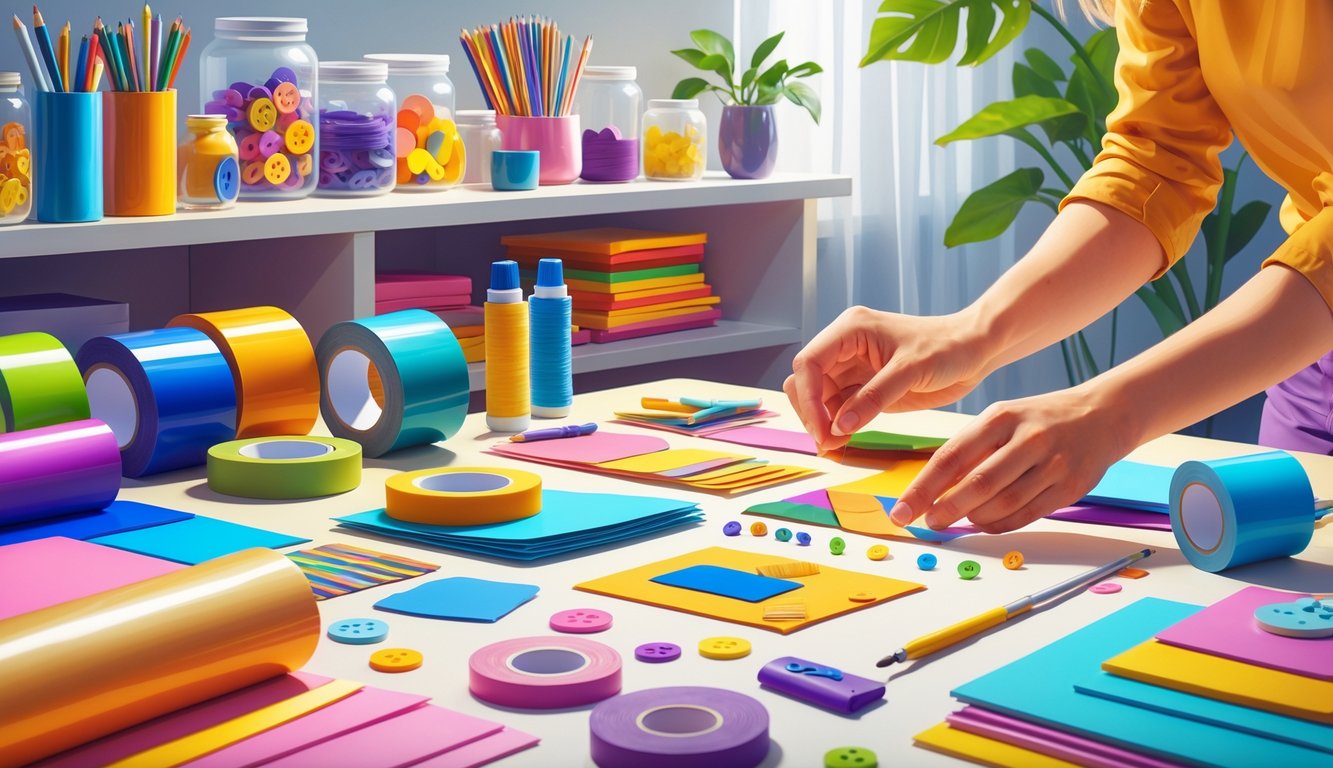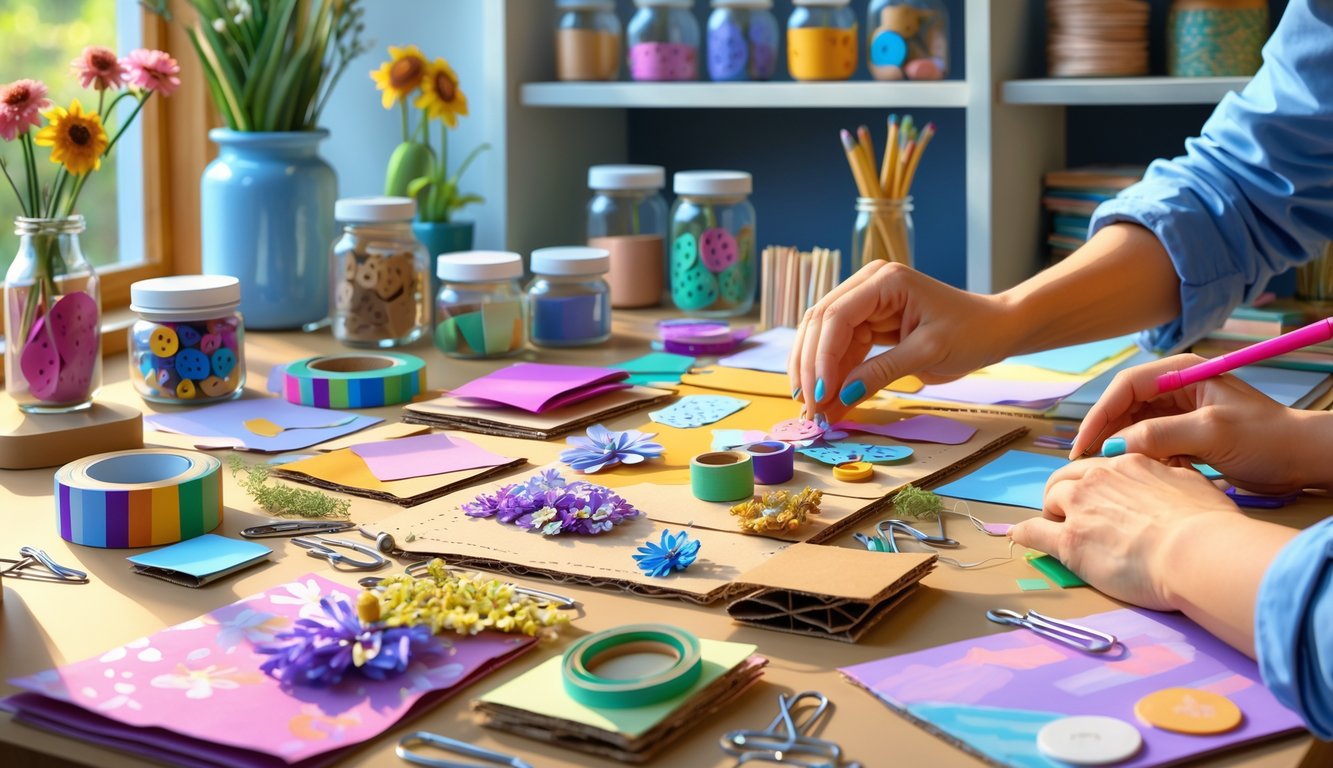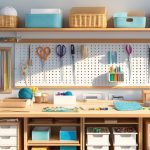
Ran out of black embroidery thread last Friday—ended up using strips of old grocery bags in my cross-stitch sampler, no shame, and, weirdly enough, folks on Instagram thought it was intentional. So apparently, we’re all just grabbing whatever’s in reach: packing foam, soap shavings, vinyl banners—if it’s weird and saves a trip to the craft store, suddenly it’s a “trend.” I keep thinking, surely people will get bored of this upcycling thing, but nope. Pinterest’s a landfill of cardboard jewelry forms, quick-drying resin kits (I got resin everywhere, disaster, don’t recommend bare hands), and bags of pre-cut felt shapes.
Michaels posted this wild trend report—over 40% of new crafters in 2025 got sucked in by “starter kits” full of stuff I’d usually toss. Abandoned chopsticks in a macramé kit? What? Apparently, it’s genius. A studio-mate of mine swears by recycled soap sculptures for classroom demos because clay’s too slow and the kids love making a mess. (My cats? They licked glitter off the counter for hours. Not ideal.) Makes me wonder why we ever freaked out about running out of “real” materials—half my junk drawer could finish a project in less time than it takes to find my keys. Then again, I tried using dryer lint as faux fur once. Immediate regret.
Why Unconventional Materials Are Transforming Crafts
Anyway, glue sticks keep rolling off my desk, but here’s the thing: my floor’s a graveyard of cardboard tubes, neoprene scraps, and old T-shirts (which, honestly, are nicer than my actual towels). Swapping out “proper” supplies for the foam from Amazon packaging? It’s not just cheap—it’s fast. Sometimes it’s ugly, sometimes it’s genius, but it gets the job done.
The Drive for Time-Saving Solutions
Cutting up cereal boxes instead of waiting for chipboard? That’s how I save time. My glue gun sits next to a broken chopstick that, weirdly, fixes more stuff than my overpriced dotting tool. Why would I drive out for felt or brads when a ripped pair of jeans is right there, begging to be chopped up?
Supposedly, according to this Common Threads survey (2024), 63% of crafters tried household junk last year just to save time. Makes sense. Nobody’s sweating over perfect color-matched paper when last week’s mail is a rainbow of weird textures, and honestly, who cares? Recycled gift wrap and empty jars don’t mess up my flow the way those complicated paper-cut templates do; those always end up as confetti anyway.
I built an entire storage unit out of battered shipping boxes while on a Zoom call. Nobody noticed. Maybe the muted laughter gave it away. But honestly, grabbing whatever’s on hand—like silicone baking mats for stenciling—saves time and sanity. Pretending crafting is slow and perfect? That ship sailed.
Benefits Over Traditional Craft Supplies
Forget the rules. Repurposed denim for patchwork organizers? Outlasts those “premium” fabric bundles (which, by the way, pill after one wash—ask me how I know). Saw crafters at Maker Faire hot-glue plastic bottle caps as mosaic tiles. Less mess, less money, more durable than glass. I’d rather spend my cash on a decent glue gun, not more “designer” felt.
Table: Quick Comparison
| Material | Cost | Durability | Prep Time | Misc Use |
|---|---|---|---|---|
| Recycled Cardboard | Low | Medium | Minimal | Storage, Base, Collage |
| Traditional Craft Felt | Medium | Low | High | Mostly Fabric Work |
| Bottle Caps | Free | High | Minimal | Mosaics, Game Pieces |
Using kitchen sponges, old receipts, or half-burnt birthday candles instead of buying another pack of “specialty” embellishments? Kills the panic, clears out the mess. Some of this stuff actually works better—try clementine bag mesh for texture and suddenly, store-bought looks boring.
Also, I keep finding Tupperware lids in my fabric bin. They’re more useful as paint palettes and circle templates than half the gadgets I own.
Rising Trends in the DIY Community
Crafting influencers (looking at you, CraftyCindy on TikTok: “Broccoli rubber bands beat store-bought looms, fight me”) are taking this to another level. I watched someone make jewelry exclusively from bread clips and safety pins. Google Trends says “upcycled art materials” searches shot up 48% in six months. That’s… a lot.
Craft groups in 2025? Absolute chaos. No one’s fighting about Mod Podge vs. white glue anymore—they’re too busy testing car window tint as a tracing lightbox. Saw a whole thread about whether coffee filters beat mulberry paper for dyeing. Who makes these rules? Nobody. It’s anarchy, and I love it.
If there’s a trend, it’s a race: fastest, weirdest, cheapest. Craft forum reviews now tag supply lists as “zero-spend” or “from trash.” Even big brands are selling curated boxes of what is basically garbage. Am I the only one who thinks that’s a scam? Guess not, since they keep selling out. Nobody’s pretending neatness or tradition is better than speed and surprise.
Most Popular Unexpected Craft Materials

I keep losing my scissors, surrounded by takeout containers, towel tubes, and those weird detergent pods nobody knows how to recycle. Every cabinet is stuffed with stuff nobody thought could be art, but teachers and “serious” crafters swear by it for quick projects. Sometimes it’s not about making something pretty—it’s about finishing before you lose interest.
Recycled Household Items
Cereal boxes. I tore one up last week for a photo frame. Designers like Justina Blakeney swear cardboard’s the best for painting—cheaper, better grip. Egg cartons? Useless until you see Pinterest loaded with floral hacks. Teachers (89% in a Teachers Pay Teachers survey) swear by them for last-minute crafts.
I don’t get why nobody talks about bread tags for mosaics. I made a geometric magnet out of them. Aluminum can tabs? Make Magazine showed how to link them into chains for jewelry or organizers. Pro tip: sand them first or paint slides right off. Who keeps a sanding block handy? Sometimes I do.
Reusable Kitchen Supplies
My kitchen’s a graveyard for silicone baking cups and produce bags, but every blog says they’re magic. Baking cups make instant paint palettes—no leaks, just peel and toss. Food52 went on about silicone mats for rolling clay. I questioned my life choices. Mesh bags? I wove one into a wall hanging; it lasted through six craft fairs (Etsy shop owner confirmed, though another said hers fell apart in soapy water).
Measuring spoons? I use them to scoop glue and make circles for collages. Makes no sense, but I’m not buying more supplies.
Eco-Friendly Cleaning Products
Scrub brushes. I see one and immediately want to thread yarn through it for… something. Microfiber cloths? CleanMama says they dye easily with natural pigments and work for stuffing plushies. EPA says 2.3 million tons of cleaning textiles hit landfills every year, so why not turn them into art?
Baking soda boxes, crusting under the sink, work as stamp blocks—slice, carve, dip, press. Bloggers call the results “mid-century.” Sure. If you squint.
Repurposed Packaging
Bubble mailers. Anna Lee (YouTube upcycler) slices the top, stuffs them, reseals, and claims they’re perfect padded phone sleeves or stamps for paint. She uses heavy-duty tape and says only one project fell apart in five years. I’m skeptical, but whatever.
Net bags from onions or avocados—layer them under papier-mâché for strength. Only reason my nephew’s mask survived his birthday tantrum. Shipping boxes from online orders? Cut, stack, tape, and suddenly you’ve got storage for pennies.
Bottle cap mosaics—why isn’t anyone selling these? Hot glue, done in minutes. Sometimes they warp, sometimes they last forever. Finished crafts always start a fight: “Are you saving the planet or just hoarding trash?” I’m not touching that one.



